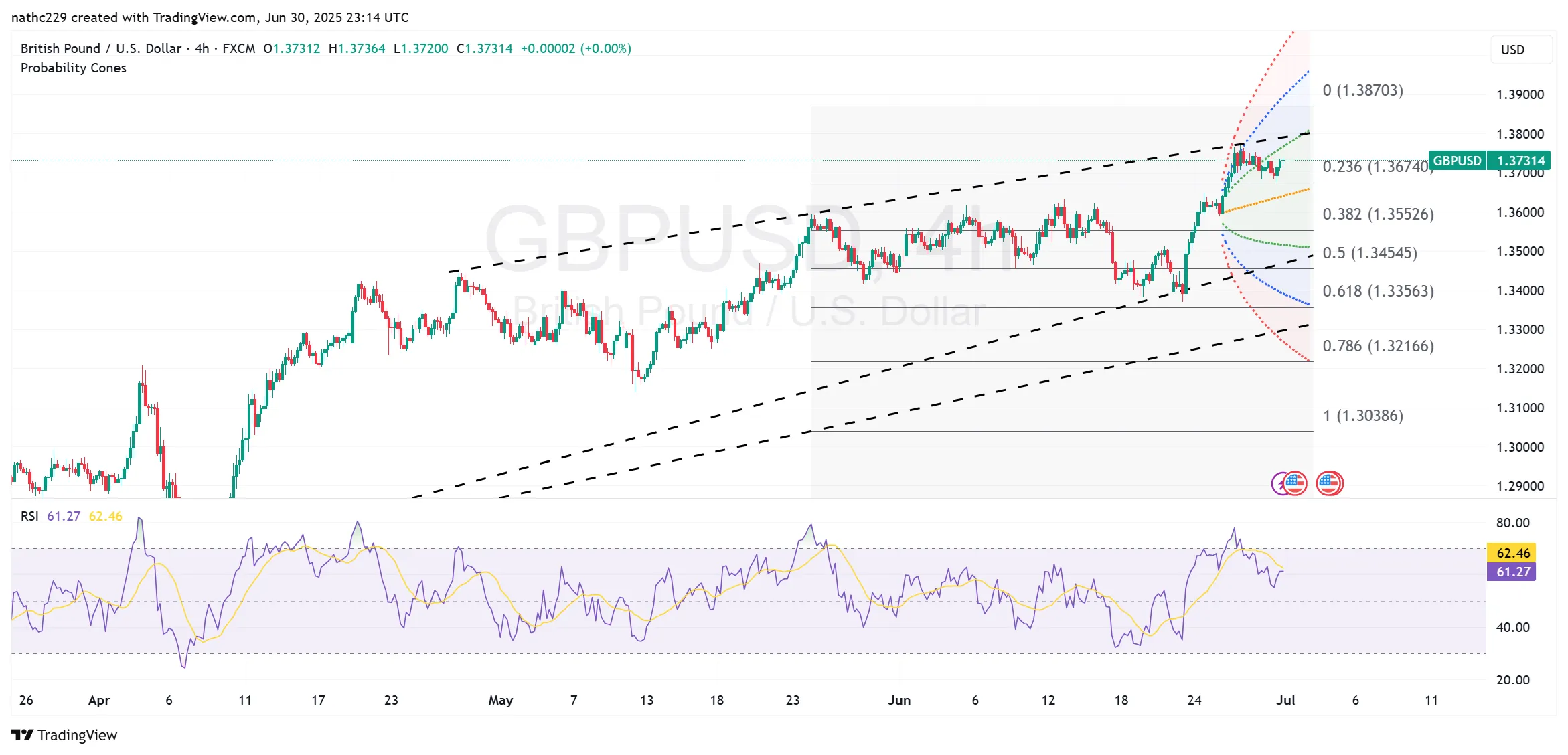
GBP/USD Holds Firm Despite Weak UK Data as Market Eyes Fed and US Yields
GBP/USD Holds Firm Despite Weak UK Data as Market Eyes Fed and US Yields
Overview
GBP/USD maintained stability despite weak UK economic data, including a disappointing current account deficit. The currency pair demonstrated resilience, trading around its recent highs, supported by declining U.S. Treasury yields and shifting expectations for Federal Reserve policy. Market participants remain attentive to upcoming U.S. economic indicators for further direction.
Technical Analysis
GBP/USD began the New York trading session near 1.3710, showing a NorAm session range between 1.3674 and 1.3722. The pair initially dipped to the lower end of its range following the release of weaker-than-anticipated UK investment data and worsening current account figures. However, the currency rebounded, closing near flat for the session.
Technically, GBP/USD remains bullish despite the brief pullback. Immediate support is identified at the June 26 low of 1.3660. Below this, additional support lies at the rising 10-day moving average around 1.3573 and further down at the 23.6% Fibonacci retracement level of the move from 1.2712 to 1.3770, located at 1.3520.
On the upside, resistance is clearly defined by the recent NorAm high of 1.3722, closely followed by the 2025 high set on June 26 at 1.3770. A decisive break above this level would target higher resistance at 1.3834, aligning with the late-July 2021 highs.
Momentum indicators, including the Relative Strength Index (RSI), remain positively inclined, though approaching overbought levels, signaling potential caution around resistance points. Traders should monitor price action closely for signs of exhaustion or reversal near these critical levels.
Market Factors and Economic Indicators
Sterling’s performance demonstrates resilience despite the UK’s deteriorating economic fundamentals, notably reflected in the growing current account deficit. This resilience partly stems from broader dollar weakness, driven by declining U.S. long-term Treasury yields and rising expectations of potential Federal Reserve rate cuts.
Recent U.S. economic indicators have heightened expectations for dovish Fed policy. Market participants now anticipate potential rate cuts later this year, with attention sharply focused on upcoming U.S. economic data, including the Purchasing Managers’ Index (PMI), Job Openings and Labor Turnover Survey (JOLTS), and payrolls reports due July 1 and July 3, respectively.
The convergence in UK and U.S. monetary policy expectations—characterized by slightly more hawkish positioning from the Bank of England compared to the Fed—supports GBP/USD strength. Market sentiment currently favors sterling bulls, especially as Fed futures indicate a dovish policy trajectory extending into 2026.
Risks and Consequences
Despite bullish sentiment, GBP/USD faces several risks that traders must consider carefully. The deteriorating UK current account deficit underscores fundamental vulnerabilities in the UK economy, potentially constraining sustained upside momentum. Should economic data continue to disappoint, these vulnerabilities could reassert downward pressure on sterling.
Additionally, geopolitical uncertainties and shifts in global risk sentiment pose risks. Recent easing of Middle Eastern tensions has supported risk assets broadly, including sterling. However, any renewed geopolitical uncertainties or escalation in conflicts could quickly reverse current market dynamics, introducing volatility.
From a technical standpoint, failure to maintain support at the critical 1.3660 level could trigger deeper corrections, bringing the pair towards lower technical supports at 1.3573 and potentially the Fibonacci support at 1.3520.
Trading Strategies
Considering current technical and fundamental factors, traders with bullish positions should carefully monitor GBP/USD price action near key resistance levels (1.3722, 1.3770, and 1.3834). Protective stop-loss orders should be placed strategically below immediate supports to safeguard against rapid market reversals.
For bearish positions, traders might wait for confirmed breaks below significant technical support levels before initiating new positions. A confirmed daily close below the 10-day moving average at 1.3573 or the Fibonacci support at 1.3520 would significantly strengthen the bearish case.
Conclusion
GBP/USD currently demonstrates notable resilience amid mixed UK economic data and shifting U.S. policy expectations. While the near-term bullish trend remains intact, traders should remain vigilant, closely monitoring key economic indicators, geopolitical developments, and technical levels to effectively navigate the evolving market environment.
